- Home
- New Kyurizukai
- Optical Physics
from Keio's Faculty of Science and Technology
Optical Physics
from Keio's Faculty of Science and Technology
Observing and controlling new
physical properties being opened
up by terahertz-wave technology
Aiming to produce world-leading research achievements, driven by the passion “I wish to shed light on the truth behind things”
An encounter with one book completely changed the life of a boy who had disliked science. Highlighting warm-hearted research scientists dedicated to the pursuit of truth, the book deeply inspired the boy and changed his course of life into becoming a researcher himself. Striving in the highly competitive world of researchers, Dr. Watanabe could broaden and accumulate knowledge about how great scientists of the past as well as those researchers he had met while studying abroad identified their research themes and pursued their studies. Dr. Watanabe says that this knowledge has been very useful in guiding his life to this day.
Shinichi Watanabe
Born in Tokyo in 1974, Dr. Watanabe graduated from the University of Tokyo, Faculty of Science, Department of Physics in 1997. In 1999, he completed the master’s course at the University of Tokyo, Graduate School of Science (Akiyama lab, the Institute for Solid State Physics). In 2002, he completed the doctoral course at the University of Tokyo, Graduate School of Science (Akiyama lab, the Institute for Solid State Physics). Doctor of Science. Then he successively served as a research fellow of the Japan Society for the Promotion of Science (JSPS), a research fellow of the JSPS Postdoctoral Fellowship for Research Abroad, a postdoctoral fellow of Swiss Federal Institute of Technology, a research associate for the University of Tokyo, Faculty of Science, Department of Physics (Shimano lab). In 2011, he assumed the current position as an associate professor at the Department of Physics, Keio University Faculty of Science and Technology.
The Research
Associate Professor Shinichi Watanabe is featured in this issue, whose field of research focuses on observing and controlling physical properties by means of terahertz light.
Investigating physical properties of condensed matters using light and controlling their properties
Observation and control of new physical properties being opened up by terahertz-wave technology
For a long time, humankind has used light with different frequencies (wavenumbers) to observe objects and change physical properties of things to improve living by harnessing electrical energy converted from light energy. In this context, coming into focus of attention is “terahertz light” that has longer wavelengths than visible light. We asked Associate Professor Shinichi Watanabe, a research specialist in THz spectroscopy about the terahertz-wave technology forefront.
What is terahertz light?
Light is indispensable for examining physical properties of things and for transforming such properties. Research based on light has developed in tandem with the development of technology to the extent that it is now contributing even to elucidating the origin of the universe – one of the greatest mysteries for humankind. Of the various kinds of light as a tool, terahertz light (“tera” signifies 10 raised to the power of 12) strongly comes into the limelight. Focused on studies based on terahertz light, Dr. Watanabe explains its advantages as follows:
“Terahertz light has extremely long wavelength, its frequency being 1/100 to 1/1000 that of visible light. Since light having a high frequency (wavelength is short) like X-ray has greater energy, we can say that terahertz light is light with a low level of energy.
The fact that its energy is extremely lower than that of X-rays means that terahertz light has significantly less adverse impact on the human body. This is why expectations are high for terahertz light as “safe light.”
You can also say that examining physical properties ofthings is investigating their energy structure. For example, when attempting to examine low-energy objects like a superconductor, use of terahertz light is the only way to see it directly. In other words, each type of light has its specialty fields of application.”
Moreover, terahertz light is very useful for penetrating materials, such as clothing, plastic packages and paper that do not transmit visible light. As such, much is expected of terahertz light for application to virtually all industrial fields – security check, semiconductor product inspection, non-destructive testing (on buildings, etc.), medical care and pharmaceutical development, to name a few. The study of terahertz light had remained unexplored until recently partly because the light can be absorbed with water and partly because it had been difficult to generate this light efficiently.
Dr. Watanabe continues: “An intriguing aspect of terahertz light is that its slow vibration allows us to observe its waveform (flying through the air) as is. I’m interested in both seeing physical properties of things and manipulating them. So it’s very exciting to be able to see firsthand what’s going on the moment light strikes an object and how they interact with each other. Due to its extremely low frequency, terahertz light also has properties very similar to radio waves. This makes it possible to produce similar effects – effects that could be obtained when an electric or magnetic field is given – without attaching an electrode to the object concerned. This is truly intriguing.”
By having both the radio wave-like property of transmitting a variety of substances together with the property of travelling straight like visible light, terahertz light covers a wide range of measurement objects. This is the greatest characteristic of terahertz light.
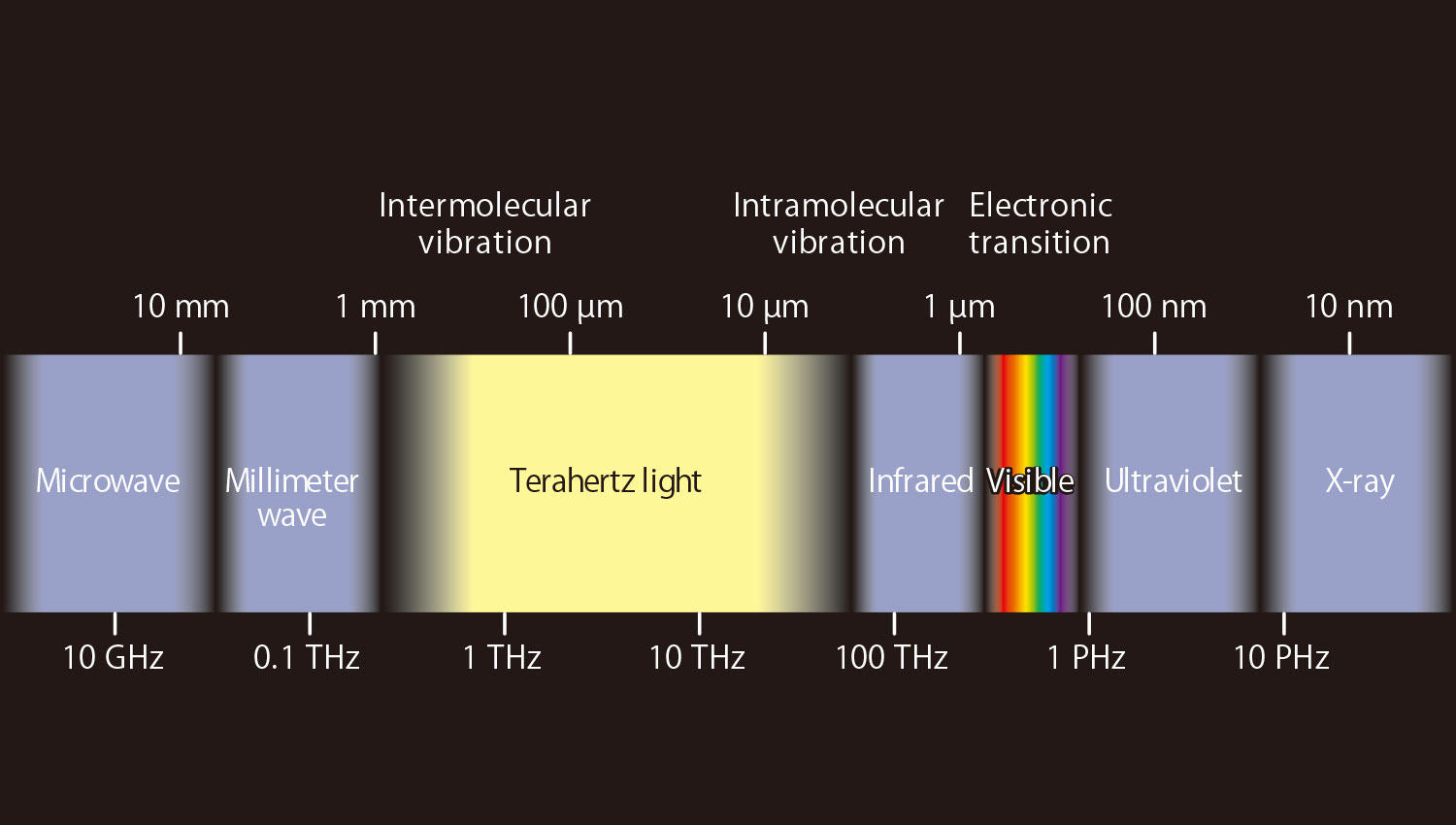
Fig. 1 What is terahertz light?
Its frequency centered around 1012 Hz, terahertz light has wavelengths 100 to 1,000 times longer than those of visible light and, as such, it is positioned at the border between radio waves and light waves. Having long wavelengths means its photon energy is low, which makes it possible for us to examine low-energy structures such as superconducting gap and intermolecular vibration.
Applying “terahertz timedomain spectroscopy”
The Watanabe lab currently employs a method known as the “terahertz timedomain spectroscopy.” By mixing longwavelength “terahertz light” and shortwavelength “near-infrared light pulse” in a transparent substance known as the “nonlinear optical crystal,” this method allows us to identify terahertz light waveforms just like an oscilloscope (a waveform measuring device used to observe behavior of electrical signals). He states: “In optical physics, we usually examine an object’s energy structure by exposing an object to light and determining how much the intensity of its reflected light or transmitted light has decreased. In addition to determining changes in light intensity, “terahertz timedomain spectroscopy” also allows us to stagger the timing of near-infrared light pulse irradiation. Thus we can obtain double amount of information – changes in “amplitude” and “phase” of light waves.” Furthermore, by exercising additional ingenuity on this method, the Watanabe lab has succeeded in accurately measuring information relating to “polarization” in addition to amplitude and phase. By rotating at a high speed the semiconductor crystal for the terahertz pulse detection at a prescribed angular velocity, it has become possible to determine the magnitude and direction of terahertz light’s electric field vector simultaneously. Thus, we are now able to accurately analyze the direction of reflected wave vector component. Highly sophisticated calculation had been required to analyze signals resulting from semiconductor crystal rotation. But Mr. Naoya Yasumatsu, then a senior, completed the task after struggling with enormous amount of calculation involved. “This method made it possible to accurately measure the direction of electric field vectors (at a given time) of terahertz-wave pulse light irradiated from two points of different height, leading us to perform highly accurate testing on the contour and surface roughness of metallic objects. As a result, we became able to distinguish unevenness down to the depth of one-thousandth of the wavelength. This achievement was publicized on the American Optical Society’s ‘Optics Letters’ (online bulletin board version).” Highly motivated, Dr. Watanabe said that he would like to expand application of this method even to the short-wave domains of infrared and visible light.
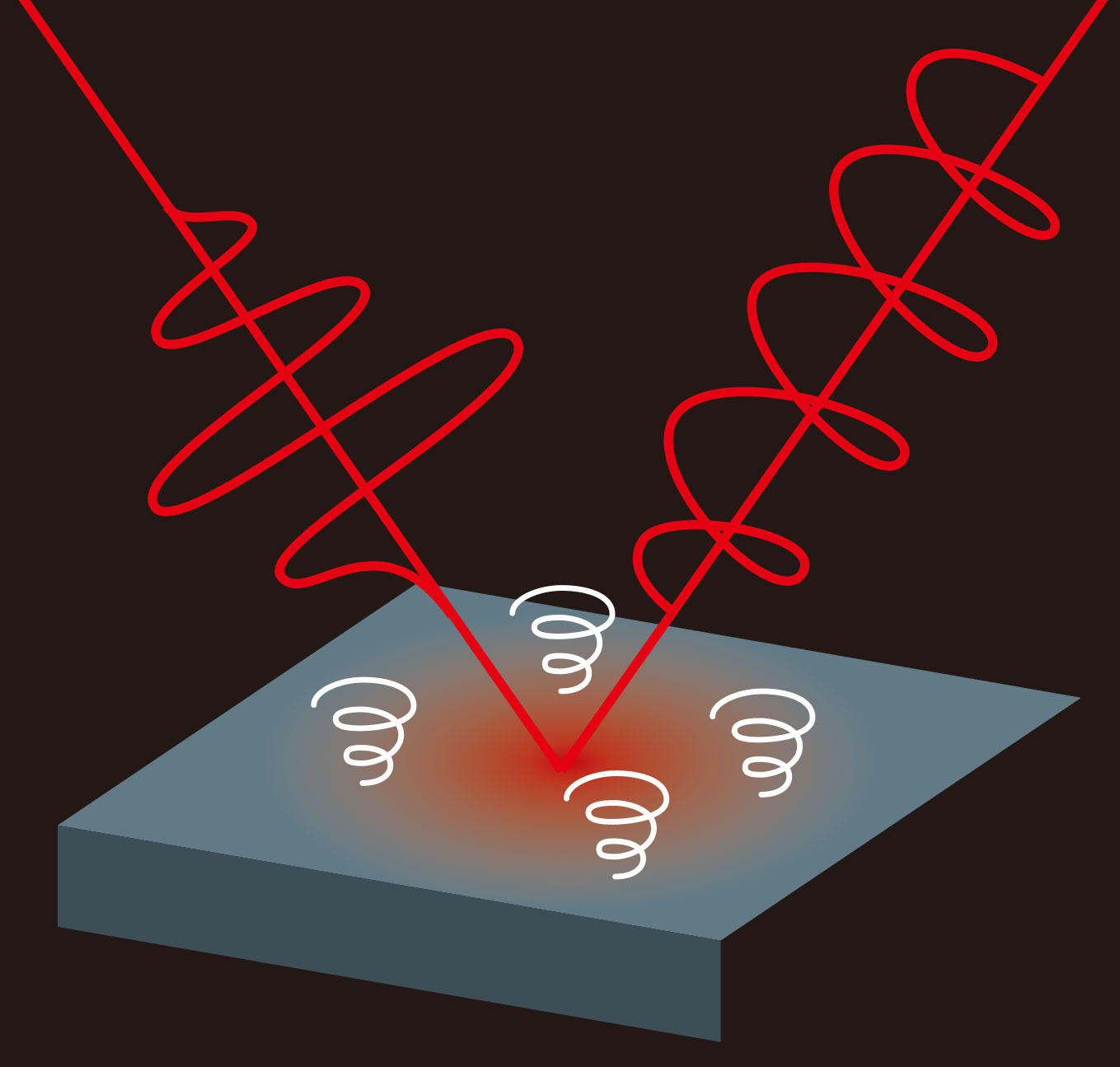
Fig. 2 Measurement of optical electric field vector waveforms
The Watanabe lab can display on monitor screen terahertz light’s electric field vector waveforms, just in a manner that you observe electrical signals on an oscilloscope. Adding information on “polarization” to “amplitude” and “phase” enables us not only to observe an object’s contour more in detail but also to examine what’s going on inside it, such as electron spin behavior and vibration of crystal lattice.
Transforming physical properties using terahertz light with large vibration amplitude
Dr. Watanabe’s research themes also include attempts to transform physical properties of an object by irradiating it with terahertz light with large vibration amplitude.
He continues: “Intrinsically, energy comparable to that of visible light is required to excite (to transfer from the ground state to the high-energy state) electrons in a semiconductor. However, terahertz light can do the same if we make its vibration amplitude extremely larger. What’s more, the great thing about terahertz light is that its waveforms are visible, which allows us to closely observe how the state of electrons changes and at which point of time.
Since the frequency of terahertz light is close to the vibration resonance frequency of lattices that constitute an object, it is relatively easy to cause resonance. By swaying the lattice greatly, we can also expect to cause a structural change to the object. We are thus able to change physical properties of objects as desired, which is expected to lead to diverse applications to new physical sciences. I’m highly motivated to establish innovative methods for controlling physical properties of things.”
We would like to keep our eye on the development of terahertz light – a field of study with great potential.
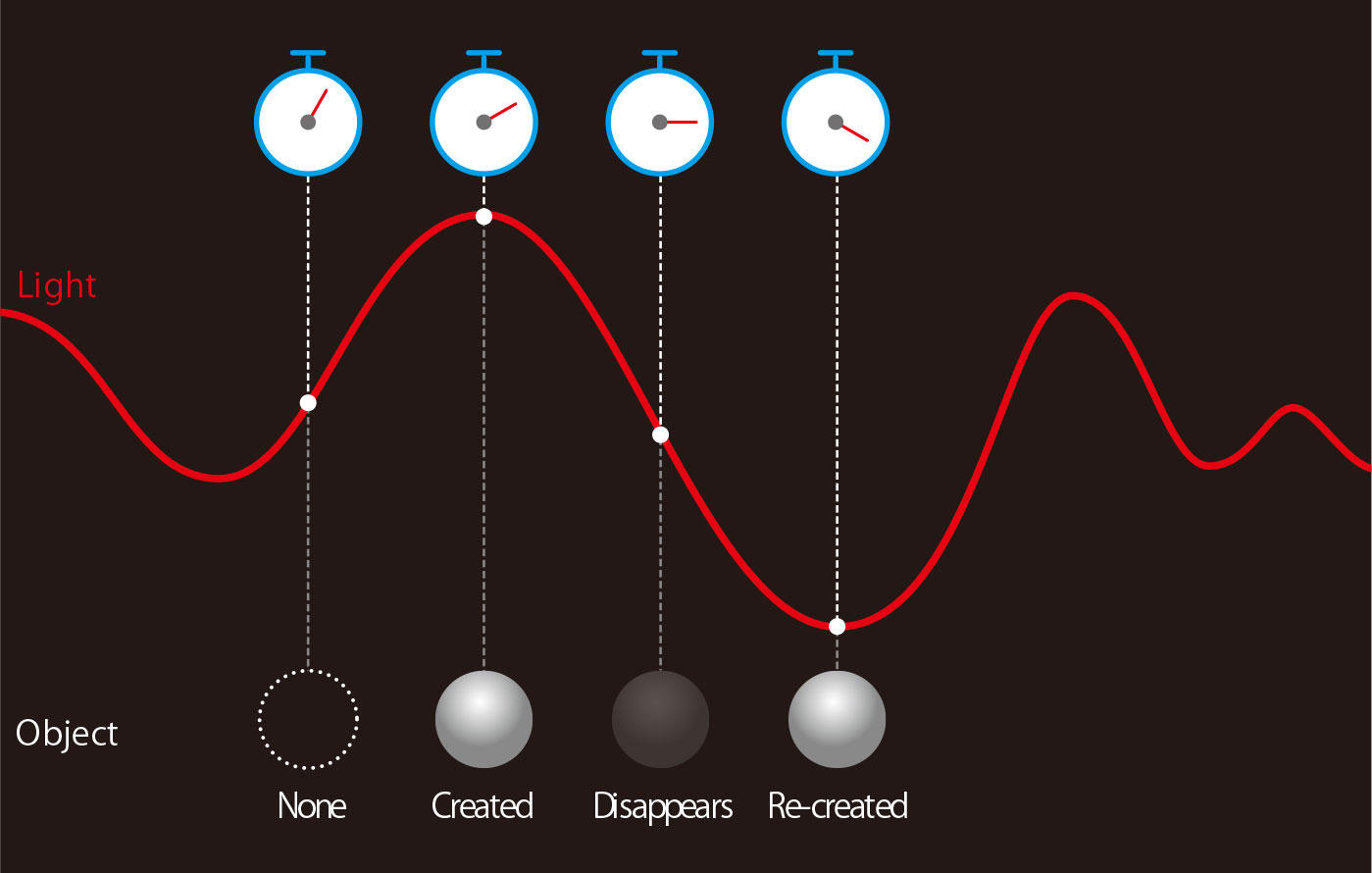
Fig. 3 Looking into physical phenomena that occur within one cycle of light wave
When an object is irradiated with light, what interaction between light and the object occurs within an ultimately short time scale? This is an intriguing aspect of optical physics. When ultrashort pulse laser, which has an extremely short pulse time width, is combined with the terahertz light generation technology, irradiation of an object with terahertz light elucidates in detail about new physical phenomena: for example, the point of time at which the electrons in the object are created or disappear.
Interview
Associate Professor Shinichi Watanabe
An encounter with one book aroused my interest in physics
What was your childhood like?
I was born as the first boy of self-employed parents engaging in electrical work business. As such, word processors and PCs were always around me in my childhood. This family environment naturally led me to take interest in computer programming. In those days, my father left home early in the morning, came back in the evening and spent most of the night at home with me. Since childhood, it had been my dream to choose an occupation by which I can spend time freely like my father.
Did you like studying?
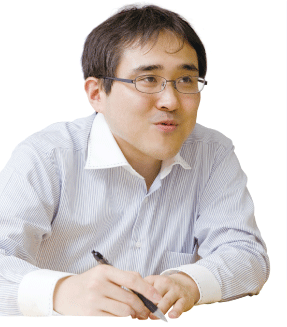
Up to my high school days, I liked mathematics and world history but science was my weak point. Science is a subject handling natural phenomena that are complex as well as diverse. As opposed to the purely logical world of mathematics, science involved things still remaining unexplained; this is why I felt some “suspicion” about explanations provided in the science textbook. The science textbook also contained sections to be learned by heart, which seemed dry and dull to me. Once I challenged a cram school teacher with this question. He said, “I can’t explain it either. You should know that physics begins with accepting the results of experiments as they are.” I still remember his remark.
As a third-year high school student, however, I happened to read a book entitled “From X-rays to Quarks” which I borrowed at a nearby public library. After reading it, I suddenly became fond of physics. The book was a fascinating account of how “Quantum Mechanics” – that great academic framework representative of the 20th century – came into being after years of heated arguments among leading physicists, each with outstanding individuality, as they struggled with the apparently complex natural phenomena. Each and every physicist who appeared in the book was full of individuality and full of human traits. I really wanted to make friends and work with these physicists at some point in the future. At the time, I realized that I would be able to find my position in this field by giving full play to my individuality and creative ideas only because physics targets complex and often incomprehensive natural phenomena.
Trying to walk a path of my own
After entering the University of Tokyo, you chose the Department of Physics as a junior, is that right?
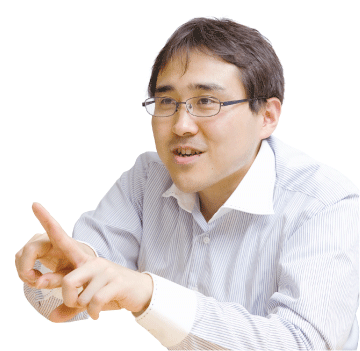
Yes. There were so many bright students around me and I was happy being able to study together with these excellent students. On the other hand, I was obsessed by a feeling that I wouldn’t be able to survive in this competitive world as a professional if I did the same thing as them.
I made up my mind to study device physics at the graduate school whereas many others chose to major in particle physics or space physics. So, I advanced to the Institute for Solid State Physics at the University of Tokyo Kashiwa (Chiba Pref.) campus. Then, as a postdoctoral fellow, I went abroad to study at the Swiss Federal Institute of Technology (EPFL). In this way, I’ve been trying to walk a unique path of my own. Fortunately, the field of my interest was the study of material science based on laser light. This meant that places and opportunities for my research activity were plentifully available around the world.
To tell the truth, I was at a loss which department to choose, the Department of Physics or Department of Applied Physics. This was because I was somewhat interested in a study that could be applied to the needs of the real world. On the other hand, I found in myself a persistent passion “I wish to shed light on the truth behind things.” After hovering this way or that, I decided to choose the Department of Physics. It was in those days that I encountered “Optics.” What attracted my interest in particular were research achievements of Dennis Gabor who had won the Nobel Prize for the invention of holography. This gave me strong motivation to become a researcher like Dennis Gabor, so I finally chose the study of optical science.
At the Institute for Solid State Physics, I studied fundamental physics of semiconductor laser structure under Associate Professor Hidefumi Akiyama. During my graduate school days, I was able to nurture the “ability to think deeply and carefully.” This ability helps me a lot even today, for which I am very grateful to Prof. Akiyama.
I went to Switzerland to study not merely to learn measurement but also the “making of things” as well. Under the guidance of Professor Eli Kapon, I engaged in the manufacture of a semiconductor quantum device structure. I was able to participate in the manufacture of quantum dot of the world’s highest quality, which was a truly valuable experience. It also remains a pleasant memory because I could work together with a number of highly individual postdoctoral fellows from many parts of the world. Furthermore, studying abroad helped me overcome my fear of communicating with foreigners. It was a great windfall for me (Laughter). I also learned a lesson that we should not hesitate to assert ourselves, especially overseas.
Then I belonged to Professor Ryo Shimano’s lab at the University of Tokyo Graduate School as a research associate, where I took up “condensed matter physics based on terahertz radiation” that led to my current main research theme. In those days, this field of study was still budding, so we had to feel our way almost in the dark. But we finally succeeded in developing an unprecedented measuring technique while learning the basics of a variety of measuring technologies at the same time.
In this manner, I was blessed with valuable opportunities to accumulate experiences – in both “optical measurement” and “sample preparation” – at these world-leading labs, which has proved to be a great asset for me as a researcher.
Setting the course of study and identifying suitable study themes as a researcher is an exhaustive task, isn’t it?
Given the highly competitive world of researchers, I’m always thinking about how I can survive the competition. In this sense, it’s my policy not to take up themes that are “in fashion.” If you jump at a theme “in fashion,” you will eventually find yourself nowhere in terms of achievements. That said, it’s true that “terahertz light” is “in fashion today.” I know my remark sounds a bit contradictory. Yet, I can say I’m pursuing original research from my own unique approach. On the other hand, if I went too far with my personal likes and focused on themes that are too far from being “in fashion,” I would surely find myself in difficulty to raise vitally needed research funds. This is the point requiring careful “consideration,” which annoys me all the time.
By the way, at the Keio University Department of Physics, “reading original texts and making presentation” (students are required to read original papers in English – from every age and everywhere – and express their comments) is a compulsory subject for seniors. In this class, I join my students to learn how famous researchers of the past opened up their fields of study using their own strategies. To produce new ideas and approaches necessary for promoting research activities, following the footsteps of great figures of the past is the best shortcut. As such, I’m striving daily to produce breakthrough research achievements while learning strategies taken by our great predecessors.
We'd like to discover yet-to-be-defined truths using our inimitable experimental techniques
What kind of research are you going to target in the future?
A number of problems remain unsolved, such as the origin of high-temperature superconductivity and mysteries of life, for which a variety of hypotheses have been proposed. Decades later, it is likely that these may become commonplace for humankind. Theories, which support experiments to prove why they are no longer mysteries, will have been established by that time. If these theories are easier to understand, they will be easier for humankind to use, contributing more to society.
I believe that natural phenomena, though apparently complex, can be broken down into simple elements that could be explained by theories. I’d like to become the world’s first to bring such “easy-to-understand theories” to light.
To refine and enhance experimental techniques is the best way to shed light on yet-to-be defined truths. Because experimental results contain a lot of clues to untangle complex natural phenomena, it’s very exciting to use these clues to solve puzzles.
In the past, for example, I created a terahertz light pulse comparable to the then world’s highest-class electric field, and used it for optical control of matters – an attempt no one else had ever challenged. Soon after assuming a post at Keio University, I also acquired a world-leading technique capable of identifying information regarding polarization of light in the terahertz frequency domain, speedily and accurately. I’d like to continue to meet the challenge of yet-to-be-defined physical property problems taking advantage of our world’s top-class techniques.
How are you spending your free time?
From junior high school days up to now, I have been an active member of an amateur brass band, playing the tuba.
Many of my favorite pieces of music are marches. Since the tuba is used to beat out monotonous rhythms, people often tell me “It’s boring, isn’t it?” But I’d rather say that many pieces of music, for which I play the tuba, are simple yet moving. It’s fun. I like things simple just as I do when it comes to work.
What aspects do you think are good about Keio University?
Teachers and administrative staff are all supportive and spare no effort to promote young and middle-class researchers like myself, for which I’m always grateful. My first impression of Keio upon assuming my post was that everything was well organized and everyone was cooperating with each other and appeared very eager to seek the highest possible achievements both in education and research. Given the superb educational environment, student’s levels of basic scholastic ability and appetite for learning are also very high, which makes me comfortable when learning and doing research with them. Synergistic effects of cooperation between teachers and students characterize Keio’s academic environment, ensuring high quality research.
Some words from students
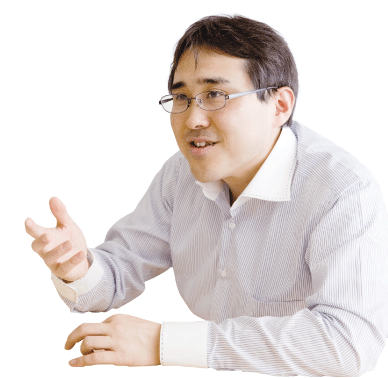
Student : It’s no exaggeration to say that most of us, the Watanabe lab students, joined the lab first and foremost because of Dr. Watanabe’s attractive character. He is a gentle as well as very caring teacher. He assigns each one of us themes according to our individual ability and interest, and follows up exactly as should be. No wonder our lab has a very good and comfortable atmosphere for us all.
(Reporter & text writer: Madoka Tainaka)


